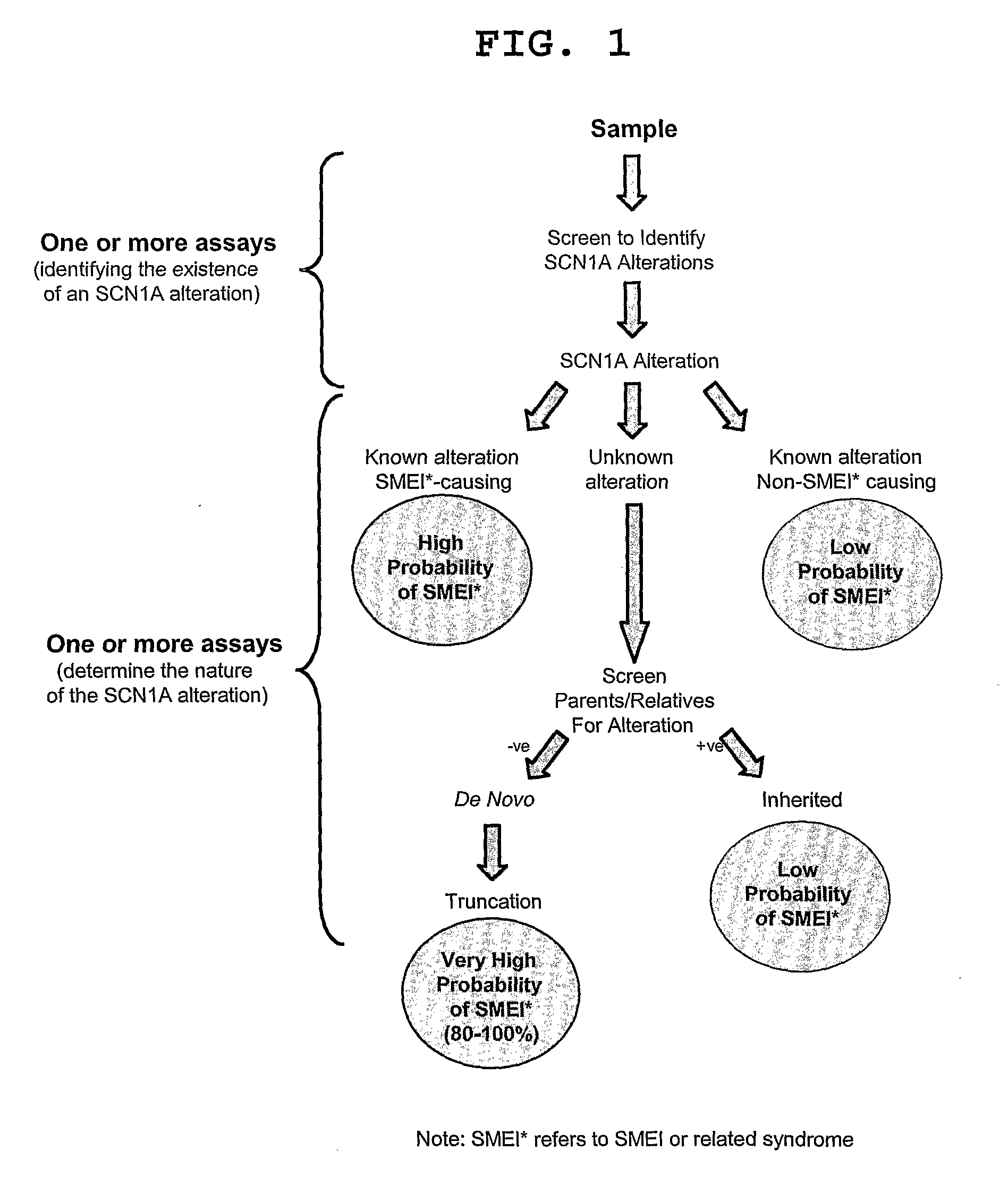Methods of Treatment, and Diagnosis of Epilepsy by Detecting Mutations in the SCN1A Gene
a technology of scn1a and mutations, applied in the field of diagnosis and treatment of epilepsy, can solve the problems of varying degrees of involuntary muscle contraction, loss of consciousness, persistent increase in neuronal excitability, etc., and achieve the effect of correcting functional deficits and reducing time and expens
- Summary
- Abstract
- Description
- Claims
- Application Information
AI Technical Summary
Benefits of technology
Problems solved by technology
Method used
Image
Examples
example 1
Patient DNA Collection
[0150]The flowchart in FIG. 1 illustrates a strategy that can be used to determine the likelihood that an alteration in the SCN1A gene is responsible for SMEI. The assay combination chosen is preceded by selecting the patient population to be examined and obtaining DNA from the sample population. The sample population may encompass any individual with epilepsy but would likely focus on children with febrile seizures as well as other patients that are suspected to have myoclonic epilepsy. For the present study, the patient population chosen included individuals that had been diagnosed with SMEI from a clinical analysis or had severe encephalopathies occurring during the first 12 months of life.
[0151]DNA from a test patient may be obtained in a number of ways. The most common approach is to obtain DNA from blood samples taken from the patient, however DNA may also be obtained using less invasive approaches such as from cheek cell swabs.
[0152]For the current study...
example 2
dHPLC Assay
[0153]Once DNA was obtained from the patients, PCR amplification of individual exons of the SCN1A gene was employed prior to analysis by high performance liquid chromatography (dHPLC). The SCN1A gene has 26 exons for which primers were designed to amplify 33 amplicons. Each exon was amplified by a single amplicon except for exons 11, 15 and 16 which are amplified in two amplicons respectively and exon 26 where 5 amplicons were used to amplify the entire exon. Table 1 provides a list of primers that were designed to analyse each exon of the SCN1A gene.
[0154]PCR amplification reactions were performed in a volume of 20 ul and were prepared in 96-well plates. For the majority of amplicons the PCR reaction consisted of 1×PCR buffer (Invitrogen), 200 uM dNTPs, 300 ng of each primer, 1.5 mM MgCl2, 100 ng DNA and 0.5 units of Taq DNA polymerase (Invitrogen). The above conditions were used for all amplicons except for exon 5, and 26(1) where 1 Unit of Taq DNA polymerase was used.
[...
example 3
[0163]PCR products from the dHPLC analysis that showed different peak patterns to wild-type may be subject to secondary assays such as DNA sequencing to identify the nature of the alteration. In the present study DNA sequencing was employed. This first involved re-amplification of the amplicon displaying an altered dHPLC chromatogram from the relevant individual followed by purification of the PCR amplified templates for sequencing using QiaQuick PCR preps (Qiagen) based on manufacturers procedures. The primers used to sequence the purified amplicons were identical to those used for the initial amplification step. For each sequencing reaction, 25 ng of primer and 100 ng of purified PCR template were used. The BigDye sequencing kit (ABI) was used for all sequencing reactions according to the manufacturers specifications. The products were run on an ABI 377 Sequencer and analysed using the EditView program.
[0164]A comparison of the DNA sequence obtained from the pa...
PUM
| Property | Measurement | Unit |
|---|---|---|
| concentration | aaaaa | aaaaa |
| concentration | aaaaa | aaaaa |
| volume | aaaaa | aaaaa |
Abstract
Description
Claims
Application Information
 Login to View More
Login to View More - R&D
- Intellectual Property
- Life Sciences
- Materials
- Tech Scout
- Unparalleled Data Quality
- Higher Quality Content
- 60% Fewer Hallucinations
Browse by: Latest US Patents, China's latest patents, Technical Efficacy Thesaurus, Application Domain, Technology Topic, Popular Technical Reports.
© 2025 PatSnap. All rights reserved.Legal|Privacy policy|Modern Slavery Act Transparency Statement|Sitemap|About US| Contact US: help@patsnap.com


